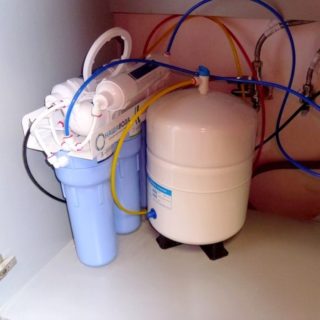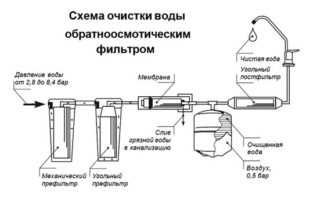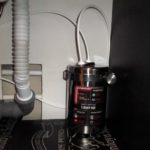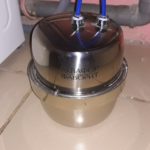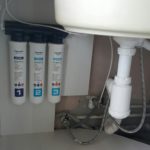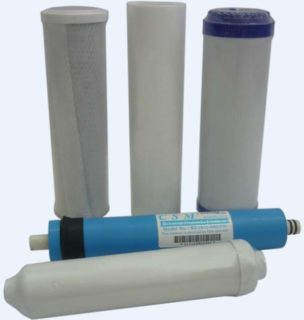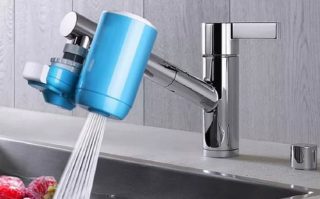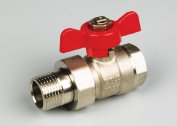The flowing filter for drinking water crashes into the water supply network of a house or apartment. It cleans the liquid from impurities - starting with salts of heavy metals and ending with organic suspensions and toxins.
Types, principle of operation and arrangement of flow filters
There are two types of flow filters. These are stationary structures installed under sinks and nozzle elements on taps. Despite external differences, the principle of action is identical for them: the liquid flowing through them is purified. As a rule, they are placed where there is a centralized water supply, since the liquid medium has already been purified additionally. But sometimes they are used in cottages, in private homes and for after-treatment after preliminary filtration.
To use such devices, driving water through them from the well, is not rational. We need a coarse cleaning system that will hold particles of sand and other large fractions of dirt.
Nozzles trap fine mechanical suspensions and some chemical components, soften unpleasant taste and smell. Designs may differ in purpose depending on the type of contamination. They are sorption and reverse osmosis type.
- softening hard water, getting rid of rust, lime and chlorine;
- removal of excess metal salts;
- getting rid of dangerous bacteria.
As a rule, a sorption system consists of 3-4 modules that are connected in series with each other. Water undergoes multi-stage purification, flowing through cartridge filters. At each stage, a different filtration method is used, due to which it is possible to achieve a high degree of purification regardless of the initial contamination of the liquid.
The three best sorption flow filter elements, according to reviews, include:
- Geyser ECO. For the production of the filter housing, chrome-plated steel was selected that is not afraid of rust and does not affect the performance of drinking water. Three-level purification is provided - mechanical, sorption, ion exchange. To improve quality, the cartridge size has been increased and the resource has been increased to 12,000 liters. The performance indicator is high - 3.6 l / min.
- Aquaphor Favorite. It is distinguished by its durability - manufacturers guarantee uninterrupted operation for up to 10 years. Filters are packaged in a steel housing. They clean the liquid from most dangerous impurities - salts of heavy metals and chlorine, toxic, oily suspensions and pathogenic bacteria. The unit is designed for increased water consumption - a resource of up to 12,000 liters, productivity - 2.5 l / min.
- “Barrier Expert Standard”. A step-by-step flow filtration system that purifies water from organics and chemistry. The built-in One Touch function allows you to quickly and easily change the cartridge. A SmartLock system is installed that does not allow parts of the device to unscrew independently. Resource and performance are slightly less than previous filters - 10,000 liters and 2 l / min, respectively.
- The filter under a sink "Geyser ECO" for water of low and average mineralization
- Multistage water purifier “Aquaphor Favorite”
- The filter for water purification "Barrier Expert Standard"
Reverse osmosis options are equipped with membrane cleaning units. A high-tech diaphragm allows only water molecules to pass through, retaining all impurities. The purification in reverse osmosis columns is maximum; at the outlet, it gives practically distilled water.It is not recommended for food use. So that the liquid can be drunk or used for cooking, you need to pass it through a special mineralizer. In domestic conditions, they are not installed so often - only in cases where the water is too bad.
Typically, reverse osmosis systems are used if it is necessary to achieve perfect purity of water in industrial facilities.
Criterias of choice
First of all, they evaluate the speed and efficiency of filtration processes, which depends on the type of device. The nozzle elements have a not too high resource and productivity: from 300 to 3000 liters at a filtration rate and 0.2 liters per minute, respectively. But their installation is available to everyone. Such devices are suitable for small families living in apartments.
The performance indicators of stationary options are much higher, the resource of their work without changing cartridges - up to six months. But not everyone can install a flow filter for cold or hot water with their own hands, because the device is cut into the water supply.
Some options are not designed for high temperature applications. You need to check whether the selected device is suitable for hot water or can only filter cold water.
Advantages and disadvantages of a stationary filtering device
Filtering devices are placed under the sink and equipped with a separate faucet. Such installations for water purification in urban environments are the most popular.
Their advantages are:
- Convenience and ease of operation. Cartridges for filtering water are easily replaced, and connection and maintenance do not take much time.
- Liquid purification from almost all contaminants.
- Improving the taste of drinking water, eliminating unpleasant odors.
The negative sides of stationary filtration plants include the need to regularly spend money on replaceable cleaning cartridges. Their replacement is required at least every year, but in domestic conditions - once every six months. However, there is no need to replace all the modules at once. It all depends on pollution. If the fluid requires constant softening, the ion-exchange apparatus wears out, with an abundance of glandular inclusions, a deironing agent.
The price of simple, but high-quality sorption-type filtration devices varies in the range of 3000–7000 rubles, the cost of reverse osmosis plants - from 7000 rubles and reaches six-figure amounts.
Pros and cons of the filter nozzle on the crane
The small device, mounted directly on the crane, is simple and inexpensive. Even a schoolboy can connect the filter - the help of the masters is not required. Its main advantage is not only the ease of installation, but also the low price and portability. Such a device can be taken with you on a trip or to the country.
The flow-through filter nozzle is also used as an additional cleaner in the construction of a water supply network with an integrated filter system. The use of a nozzle device improves the taste, color and smell of water, provided that a preliminary cleaning has been carried out.
The prices of flowing filter nozzles for water purification depend on the equipment and brand, and range from 130 to 3500 rubles.
If the water is very polluted, the use of nozzles becomes irrational: a tiny filter simply can not cope with them. Also, the disadvantages of devices of this type include a small amount of absorbent material and the need for a reservoir for storing clean water.
To select a suitable filtration device, evaluate the degree of contamination of the water, the amount of consumption and the necessary degree of purification. Additionally, find out how much the consumables cost for the model you like and how easy it is to find them on sale.Usually flow cleaners have no problem with this.
